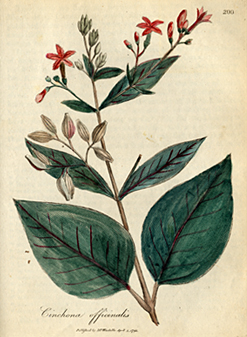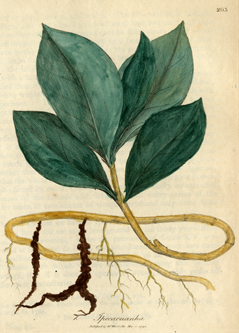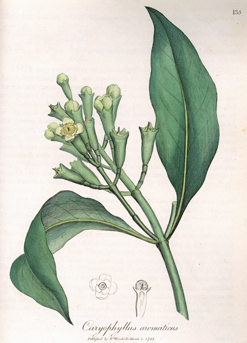Peruvian Bark
Cinchona officinalis L.
Courtesy Library of the College of Physicians of Philadelphia.
Cinchona officinalis L. was one of several species of South American trees that yielded “Peruvian” or “Jesuit’s” bark for the treatment of intermittent fevers.
The famous Swedish botanist Carl Linnæus named the genus for the Countess of Cinchona, wife of the viceroy of Peru, who was said to have introduced the drug into European medicine. The epithet, officinalis, indicates it was then officially accepted as a medicinal herb.
This and the four following engravings, plus the one on the following page, are from Thomas Woodville’s Medical Botany (London, 1793).
Cinchona Bark
(Peru and Bolivia)
It was no accident that the largest amount of a single medicine purchased by Israel Whelan for the Corps was fifteen pounds of “Pulv. Cort. Peru” otherwise known as cinchona bark or simply bark. One of the great panaceas of the era, cinchona bark arrived in Europe from South America in the early 1600s as a specific cure for intermittent fevers (malaria). As a specific it rocked traditional medical theories, which maintained that disease came from humoral imbalances within the body. As one of the few drugs that actually cured a disease, cinchona was soon tried against other fevers and many other constitutional ailments even though it had little if any effect.[1]Saul Jarcho, Quinine’s Predecessor: Francesco Torti and the Early History of Cinchona (Baltimore: Johns Hopkins University Press, 1993). [Andrew Duncan] [WorldCat says William Lewis], The … Continue reading
Quinine, the main active ingredient of cinchona bark was not isolated until 1820 by French pharmacists Pelletier and Caventou.[2]Friedrich A. Flückiger & Daniel Hanbury, Pharmacographia (London: Macmillan and Co., 1874), 320-321. Only ten or twelve ounces of this alkaloid would have equaled the medicinal power of the Corps’ bulky container of powdered bark. The cinchona probably arrived in Philadelphia via London merchants, rather than directly from South America.
Opium and Laudanum
(Middle East)
From the list of drugs, opium and its tincture (laudanum), filled a niche still required in today’s therapeutics, i.e., opiate pain reliever.
Four of the top 100 drugs prescribed in 2002 were derived in part from opium, including the number one medicine, hydrocodone with acetaminophen. And while opium and its preparations were used for the relief of pain, they were also the sedatives and hypnotics of choice two hundred years ago. About the same time as the Lewis and Clark Expedition, German pharmacist Friedrich Sertürner was developing the method to extract morphine from crude opium, thereby beginning the era of alkaloidal chemistry. As in the case of cinchona and quinine, however, this discovery would come too late for the Corps, which was required to take the bulkier crude drug along for the 8,000-mile journey.[3]“2002 Rx Market: A Look in the Rear View Mirror,” Drug Topics 147 (17 March 2003): 37-38, 40, 44, 60, 62. Aaron J. Ihde, The Development of Modern Chemistry (New York: Harper & Row, … Continue reading
Lewis, as Jefferson’s private secretary, may have read the following from the Edinburgh New Dispensatory, a book in the president’s library:
Egypt, Persia, and some other provinces of Asia, have hitherto supplied us with this commonly: in those countries, large quantities of poppies are cultivated for this purpose. . . . Opium, when taken into the stomach . . . gives rise to a pleasant serenity of mind, in general proceeding to a certain degree of languor and drowsiness. . . . No substance can have a better title to the appellation of sedative than opium. . . . Indeed there is hardly any affection, in which it may not, from circumstances, be proper; and in all desperate cases, it is the most powerful means of alleviating the miseries of patients.[4]Edinburgh New Dispensatory (1791), 240-243.
Hypodermic syringes were a half-century in the future, so physicians of the early 19th century administered opium orally, often in the form of a simple rolled pill. As a valuable drug, opium was often adulterated, therefore druggists like Gillaspy and Strong carefully examined each shipment that arrived. Their reputation as dealers in quality drugs depended largely on the potency of their opium.[5]Jacob Bigelow, A Treatise on the Materia Medica, Intended as a Sequel to the Pharmacopoeia of the Untied States (Boston: Charles Ewer, 1822): 271-272; Freedley, Principal Trades, 149.
The distinctive, knobby, dark-brown roots of Cephaelis ipecacuanha Brotero,[6]Felix Brotero (1744-1828) was the Portugese botanist who published the first official description of Cephaelis ipecacuanha. were greatly prized by physicians and pharmacists. The low shrubby plant was not especially easy to find in the tropical rain forests of South America. Cephaelis refers to those little “heads” on the root; ipecacuanha is a Portugese transliteration of a compound Tupi Indian name for the “low vine that makes one vomit.”
Ipecac
(Brazil)
A drug sometimes combined with opium was ipecac, one of the most versatile medicines of the early modern period. Introduced into Western therapeutics in the late 1600s from South America, ipecacuanha quickly gained stature as a treatment for dysentery and as a reliable emetic and diaphoretic. Intentionally inducing vomiting or sweating was viewed at the time as a good way to alter the body’s balance and encourage the restoration of health. Ipecac remains an official drug, although its status as an emergency emetic has declined in recent years. In 1803, most ipecac roots were dug in Brazil for exportation.[7]John Uri Lloyd, Origin and History of all the Pharmacopeial Vegetable Drugs, Chemicals and Preparations, Volume 1 (Cincinnati: Caxton Press, 1921): 168-176; Edinburgh New Dispensatory (1791), … Continue reading
Camphor
(Sumatra)
Another exotic carried along by Lewis and Clark that is still official is camphor. One contemporary author described it as “a very peculiar substance . . . chiefly extracted from the wood and roots of a tree growing in Sumatra.” The collection of camphor was described by Marco Polo and in the Arabian Nights. Considered a concrete essential oil, the drug was administered orally to combat fevers through inducing perspiration.[8]Lloyd, Pharmacopeial Vegetable Drugs, 39-40; Edinburgh New Dispensatory (1791), 156-157.
Copaiba
(Brazil and Venezuela)
Buried in the usual lists of medicines carried by the Corps of Discovery is “Balsam of Copaiba.” This soothing liquid came from tapped trees in the Amazon basin. Although it had other applications, copaiba (pron. co-pie-buh) was mainly used for the treatment of gonorrhea. When consumed internally, it produced a characteristic odor to a patient’s urine and was thought to soothe inflammation caused by venereal disease. As experienced army officers, Lewis and Clark knew they needed to be prepared to treat VD, so they brought along copaiba, calomel, and penile syringes.[9]Lloyd, Pharmacopeial Vegetable Drugs, 110-116; Bruce Paton, Lewis & Clark: Doctors in the Wilderness (Golden, CO: Fulcrum, 2001), 50-51.
Asafetida
(Iran and Afghanistan)
Of all the imported drugs, perhaps the most notorious was asafetida, also known as “devil’s breath.” This nasty smelling drug from Persia was known since ancient times. Widely consumed on the theory that anything that smelled that bad had to be good for something, asafetida’s serious use by 1800 had declined to the treatment of nervous complaints and flatulence. Its folk use to ward off colds and flu continued into the twentieth century. Why the Corps took an entire pound of this smelly substance is unclear. There is no apparent record of it being used during the journey.
Cloves
Caryophyllus aromaticus L.
Reproduced courtesy of the Department of Special Collections, General Library System, University of Wisconsin-Madison.
Used for centuries as a spice, cloves also contain eugenol, an essential oil effective in the treatment of dental pain. Caryophyl-lus, the old generic name, referred to the fruit’s pinkish color when fresh, which changes to brown when dried. Today it is said to belong in the genus Syzygium, from a Greek word meaning together–a reference to the plant’s paired branches and leaves.
Columbo Root
(Mozambique)
When Gillaspy and Strong packed up half a pound of columbo root for the Corps, they probably thought the drug came from Ceylon (modern Sri Lanka). For decades, Portuguese traders had a monopoly on this drug and hid its origins. Portuguese ships would stop on the East coast of Africa, purchase the roots from local gatherers, and then carry them along to India on their journeys before returning home to Europe. At first called kalumb, the drug’s name shifted to variations of “colombo,” the capital city of Ceylon. In the 1820s its origins were clarified. No matter what its name, columbo was never an important drug, and was probably included by Lewis as a tonic and restorative.[10]Flückiger & Hanbury, 22-24; Edinburgh New Dispensatory (1791) 175-176.
Cinnamon, Nutmeg, and Cloves
(Sri Lanka and Moluccas)
Ceylon was the source for cinnamon, which like other spices were carried in the same ships, exchanged by the same dealers, and sold by apothecaries along with drugs.
For centuries there had been a fine line between these precious items. In both regular and folk medicine, pungent spices were taken to improve digestion. Some authors have speculated that Lewis bought the cinnamon, nutmegs, and cloves to flavor their drug preparations. It is just as likely that the captains bought them for culinary purposes. They could also have been used to prepare bait for beaver traps.[11]Flückiger & Hanbury, Pharmacographia, 466-474, 451-456, 249, 255. Moulton, Journals, 27 January 1806, 10 January 1806. Mace and vanilla were also said to be effective for this purpose.
Rhubarb
Rheum palmatum L.
Reproduced courtesy of the Department of Special Collections, General Library System, University of Wisconsin-Madison.
Although this medicinal rhubarb plant can grow to more than six feet in height, the active constituents are found below ground in its roots. Little used in the United States since 1900, Rheum (pron. “room”) remains a popular laxative throughout the rest of the world. Rheum comes from a Greek word meaning stream, or flow; palmatum describes the lobed, palmate (hand-shaped) outline of the leaf
Rhubarb
(China)
Often conflated with the common culinary plant called rhubarb, Rheum or China Rhubarb was a botanical laxative with a long and distinguished history. Used as medicine since ancient times in China, the roots and rhizomes of rheum arrived in the West in the second century BC. Throughout the Middle Ages up to modern times, medicinal rhubarb was an active item of trade.[12]Flückiger & Hanbury, 442-451. By the time of Lewis and Clark, medicinal rhubarb was viewed as “a mild cathartic, which operates without violence or irritation. . . . In some people, however, it always occasions severe griping. Besides its purgative quality, it is celebrated for an astringent one, by which it strengthens the tone of the stomach and instines, and proves useful in diarrhoea.” It was for this apparent dual activity that physicians valued rhubarb.[13]Edinburgh New Dispensatory (1791), 263-4. Rhubarb remained an officially recognized drug for the next 150 years.[14]National Formulary, 10th ed. (Washington, DC: American Pharmaceutical Association, 1955): 493. For an excellent study of this drug, see Clifford Foust, Rhubarb: The Wondrous Drug (Princeton, NJ: … Continue reading
Tragacanth
(Persia)
A plant derivative that still finds use 200 years later is tragacanth. The dried gummy exudation from Astragalus gummifer or other species of Astragalus, tragacanth is used today as a “suspending agent in lotions, mixtures, and extemporaneous preparations and prescriptions.”[15]David B. Troy, ed., Remington: The Science and Practice of Pharmacy (Philadelphia: Lippincott, 2006), 1076. The captains could have used it as well to make up pill masses.[16]Edinburgh New Dispensatory (1797), 257.
Essence of Peppermint
Of all the botanical drugs purchased by Whelan, only peppermint (Ess. Menth), Mentha x piperita L. (“peppery mint”) and other species, grow in North America. Physicians of the time prescribed essence of peppermint for stomach complaints or for “chills.” As one book put it, mint “diffuses a glowing warmth through the whole system.”[17]Ibid.,196, 313. On 24 August 1805, Lewis found that one of his men, Peter Weiser, “very ill with a fit of the cholic” and administered “a doze of the essence of Peppermint and laudinum which in the course of half an hour so far recovered him that he was enabled to ride my horse and I proceeded on foot and rejoined the party.”[18]Moulton, Journals, 24 August 1805. While this essence, or alcoholic solution containing the “essential oil” of peppermint, was probably imported, it could have been produced from domestic mint. Photo: Northeast wetland flora: Field office guide to plant species. Northeast National Technical Center, Chester, Pennsylvania.
Notes
| ↑1 | Saul Jarcho, Quinine’s Predecessor: Francesco Torti and the Early History of Cinchona (Baltimore: Johns Hopkins University Press, 1993). [Andrew Duncan] [WorldCat says William Lewis], The Edinburgh New Dispensatory (Philadelphia, T. Dobson, 1791), 250-254. |
|---|---|
| ↑2 | Friedrich A. Flückiger & Daniel Hanbury, Pharmacographia (London: Macmillan and Co., 1874), 320-321. |
| ↑3 | “2002 Rx Market: A Look in the Rear View Mirror,” Drug Topics 147 (17 March 2003): 37-38, 40, 44, 60, 62. Aaron J. Ihde, The Development of Modern Chemistry (New York: Harper & Row, 1964), 167. |
| ↑4 | Edinburgh New Dispensatory (1791), 240-243. |
| ↑5 | Jacob Bigelow, A Treatise on the Materia Medica, Intended as a Sequel to the Pharmacopoeia of the Untied States (Boston: Charles Ewer, 1822): 271-272; Freedley, Principal Trades, 149. |
| ↑6 | Felix Brotero (1744-1828) was the Portugese botanist who published the first official description of Cephaelis ipecacuanha. |
| ↑7 | John Uri Lloyd, Origin and History of all the Pharmacopeial Vegetable Drugs, Chemicals and Preparations, Volume 1 (Cincinnati: Caxton Press, 1921): 168-176; Edinburgh New Dispensatory (1791), 211-213; Bigelow, Materia Medica, 232-234. |
| ↑8 | Lloyd, Pharmacopeial Vegetable Drugs, 39-40; Edinburgh New Dispensatory (1791), 156-157. |
| ↑9 | Lloyd, Pharmacopeial Vegetable Drugs, 110-116; Bruce Paton, Lewis & Clark: Doctors in the Wilderness (Golden, CO: Fulcrum, 2001), 50-51. |
| ↑10 | Flückiger & Hanbury, 22-24; Edinburgh New Dispensatory (1791) 175-176. |
| ↑11 | Flückiger & Hanbury, Pharmacographia, 466-474, 451-456, 249, 255. Moulton, Journals, 27 January 1806, 10 January 1806. Mace and vanilla were also said to be effective for this purpose. |
| ↑12 | Flückiger & Hanbury, 442-451. |
| ↑13 | Edinburgh New Dispensatory (1791), 263-4. |
| ↑14 | National Formulary, 10th ed. (Washington, DC: American Pharmaceutical Association, 1955): 493. For an excellent study of this drug, see Clifford Foust, Rhubarb: The Wondrous Drug (Princeton, NJ: Princeton University Press, 1992). |
| ↑15 | David B. Troy, ed., Remington: The Science and Practice of Pharmacy (Philadelphia: Lippincott, 2006), 1076. |
| ↑16 | Edinburgh New Dispensatory (1797), 257. |
| ↑17 | Ibid.,196, 313. |
| ↑18 | Moulton, Journals, 24 August 1805. |
Experience the Lewis and Clark Trail
The Lewis and Clark Trail Experience—our sister site at lewisandclark.travel—connects the world to people and places on the Lewis and Clark Trail.
Discover More
- The Lewis and Clark Expedition: Day by Day by Gary E. Moulton (University of Nebraska Press, 2018). The story in prose, 14 May 1804–23 September 1806.
- The Lewis and Clark Journals: An American Epic of Discovery (abridged) by Gary E. Moulton (University of Nebraska Press, 2003). Selected journal excerpts, 14 May 1804–23 September 1806.
- The Lewis and Clark Journals. by Gary E. Moulton (University of Nebraska Press, 1983–2001). The complete story in 13 volumes.






